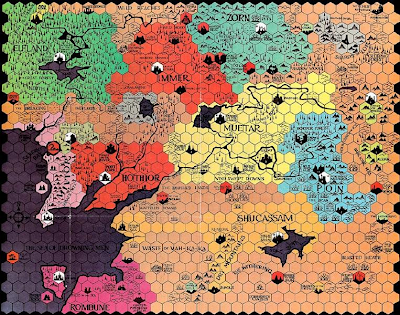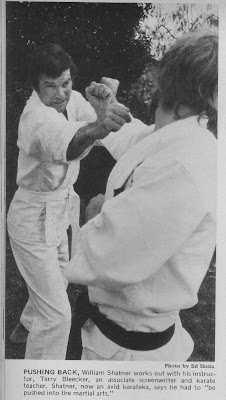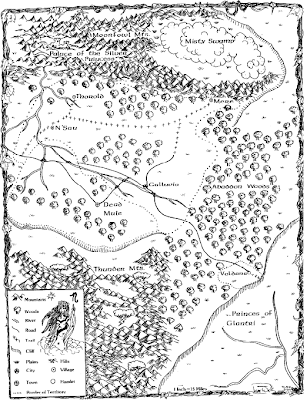Here’s a chart from Richard Snider’s
Powers & Perils that I found somewhere online. P&P was published as part of THE Avalon Hill Game Company’s master plan to conquer the RPG world by simultaneously releasing three completely non-compatible fantasy role-playing games. Somehow that strategy didn’t quite work out. But hey, it got Tom Moldvay’s
Lords of Creation into print, so the effort wasn’t completely wasted.
As I recall you’re allowed to roll once on the table below for each full decade of age of your starting PC, but you can choose not to roll if you don’t want to. Nearly every item on the chart is beneficial (37-41 and 85-86 being notable exceptions), so only the faintest of heart would skip the opportunity. I’m not familiar with P&P to be able to explain any of the game mechanics below, but I love charts like this and wanted to share.
Special Events01–20 None
21–28 Increase your Current Ability in one characteristic by 1d6
29–32 Increase your Current Ability in two characteristics by 1d6+2 or in one characteristics by 1d10+2.
33 Special Attribute
34–36 Increase any Current Abilities by a total of 2d10. The total may not exceed the number rolled.
37 Your face bears pox scars from an old disease. Reduce Appearance 50% rounded down.
38 You have a pronounced limp from an old wound. Reduce Agility by 20% rounded down.
39 You recently escaped from a prison in a neighboring nation. You are a wanted felon in the land of the Referee’s choice.
40-41 As for 39 except you escaped from a prison in the nation that the adventure is starting in within the last 1d6 days.
42 You are under a powerful Geas, the referee will set all parameters of its effect.
43 You were raised among the Faerry. In addition to normal human Knowledge, you speak the tongue of the Faerry Sidh with an EL of 60.
44 Special Attribute [Roll on a second table of bonus magical powers]
45–47 Past luck garners you d100 SC.
48 As 45–47 except 2d10+10 GC.
49 As 48 except 1d3 bars of Silver.
50-51 You possess 1d3 Small Jewels of unknown value. If your Station is zero, you stole them.
52 You have 1d2 Medium Jewels of unknown value. If your Station is 1 or less, you stole them.
53 You possess 1 Large Jewel of unknown value. If your Station is 2 or less you stole it.
54–56 Roll 1d6. On a 1-3 as for 50-51, 4-5 as for 52 and 6 as for 53, except you know the value of the jewels.
57 Increase any Native Abilities by a total of 1d6. (Increase Maximum Abilities as appropriate afterwards).
58 You have a piece of Jewelry. You have no idea where you got it or what it is worth. You have had it since birth. The Referee will determine the type of jewelry.
59–62 Take any 3 items from the Equipment List with a combined value under 40GC and an individual value of at least 5GC.
63 Take any 1 item from the Equipment list with a value between 10 and 100GC
64 If your Station is 4 or higher, you are a prosperous land owner in your homeland. Roll 1d10x1d10 to determine the hundreds of acres that you control. (Your income from this is 1SC per acre per year). If your Station is 3 or less you control 1d10x1d10 acres as a personal freehold. (Income from this land is 3CC per acre per year). All income figures are gross values.
65 You have a random Magic Amulet.
66 Special Attribute. [Roll on a second table of bonus magical powers]
67–70 Training with a Skilled Master raises your Expertise with all weapons in a weapon type of your choice to the maximum EL currently possible for your Character. No Expertise Cost is assessed for this training.
71 You have a random magic weapon.
72 You have a random type of magic armor.
73 You have an authentic map to a large treasure. Referee will roll 1d6+14 on the Map Table for it’s value.
74 You possess 1d6 doses of a random Potion or Elixir.
75 You possess 1d6 doses of a random Natural Magic material.
76 You have 1d6 doses of a random Powder.
77 Special Attribute. [Roll on a second table of bonus magical powers]
78–81 You have a Pet. It is a normally wild animal. The Referee will determine its species and full parameters.
82 You have a Magic Item. The Referee will determine what it is.
83-84 Apprentice in the Magic Path of your choice if your Native Intelligence is 15 or higher. If not, as for 82.
85-86 You have a powerful enemy. Gain 1d10x10 Experience Points and D100 SC. The Referee will determine the enemy based on your actual gain, i.e. the more gained, the more powerful the enemy. The enemy will seek revenge whenever possible.
87 Raise your Native Ability in any Mental Attribute by 1d3*. (Raise Maximum Ability as appropriate afterwards).
88 Special Attribute. [Roll on a second table of bonus magical powers]
89–91 You have a Personal Contact among your people. The Referee will determine his or her parameters.
92-93 As 89–91 except the Contact must reside in the area that the party is starting in.
94 As for 87 except Native Ability in any Physical Attribute, including Constitution and Appearance, may be increased.
95–96 You have a friend. You are accompanied by a Character Class NPC. The Referee will determine the attachment and all parameters of the friend. The CEL of the friend is 1d6+4. He may not be a magic-user. He will defend his friend to the death.
97 You were raised among the Elves. In addition to Human Knowledge, you speak the tongue of the Elf Sidh with an EL of 60.
98 An old friend, who once saved your life, is lost in a hostile land. You are aware of his whereabouts. He holds the key to a great treasure that both of you were searching for.
99 You are the master of a Firesnake.
100 You have come under extraordinary influences. The referee will determine something exceptionally good or bad. If he does not wish to do so, roll three times on this table or twice on the Special Attribute table.
 Bones of Power was an attempt by Bob Liddil to do charts like his d30 books, but for a pair of funky six siders: a white die with a skull & crossbones instead of the number one and a black die with a devil face where the one should be.
Bones of Power was an attempt by Bob Liddil to do charts like his d30 books, but for a pair of funky six siders: a white die with a skull & crossbones instead of the number one and a black die with a devil face where the one should be.

















































































































































.jpg)

































.png)








.jpg)













